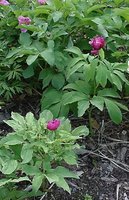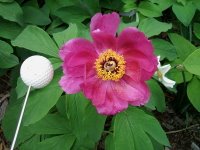 Paeonia tenuifolia ssp lithophila, a dwarf form of Fern-leaf Peony; today the sun was out so the flowers opened fully.
Paeonia tenuifolia ssp lithophila, a dwarf form of Fern-leaf Peony; today the sun was out so the flowers opened fully. Same plant but on a cloudy day; this is meant just to give an idea of plant form. Windy and rainy weather a few days ago have twisted the stems a bit, and with the leafs fully out on the overhanging tree branches these are somewhat more shaded than they would like.
Same plant but on a cloudy day; this is meant just to give an idea of plant form. Windy and rainy weather a few days ago have twisted the stems a bit, and with the leafs fully out on the overhanging tree branches these are somewhat more shaded than they would like. Flower of a seedling of tenuifolia proper, seed from a J Halda collection near Vidin, Bulgaria.
Flower of a seedling of tenuifolia proper, seed from a J Halda collection near Vidin, Bulgaria._________________________________
 Paeonia mlokosewitschii, the Golden Peony, opened today in the datum beds although it has been open for a few days already in another bed. This is the palest yellow any of my mloko's have shown as, and is growing in the woodland bed.
Paeonia mlokosewitschii, the Golden Peony, opened today in the datum beds although it has been open for a few days already in another bed. This is the palest yellow any of my mloko's have shown as, and is growing in the woodland bed. From the same seed lot and in the datum bed, a couple of apparent hybrids of mloko. The buds were photographed yesterday, and the opening flower this morning.
From the same seed lot and in the datum bed, a couple of apparent hybrids of mloko. The buds were photographed yesterday, and the opening flower this morning. I wrote "apparent hybrids" because to the best of my knowledge plants from wild-collected seed do not show these shades of colour, but they are not uncommon in plants grown from garden-origin seed, where cross-pollination with other species is possible.
I wrote "apparent hybrids" because to the best of my knowledge plants from wild-collected seed do not show these shades of colour, but they are not uncommon in plants grown from garden-origin seed, where cross-pollination with other species is possible. Although unusual (but perhaps not uncommon among mloko hybrids) and interesting the colour is not exactly the cleanest and I was getting myself set to sell this plant off this year. But the fragrance!! oh my, has convinced me to keep it around: a strong scent of allspice and orange. Strange, didn't notice any scent to it last year.
Although unusual (but perhaps not uncommon among mloko hybrids) and interesting the colour is not exactly the cleanest and I was getting myself set to sell this plant off this year. But the fragrance!! oh my, has convinced me to keep it around: a strong scent of allspice and orange. Strange, didn't notice any scent to it last year.___________________________________
 This just opened, Paeonia officinalis ssp villosa. Apothecarie's Peony. Similar in flower to P mollis, but taller and with different foliage and seed shape and etc.
This just opened, Paeonia officinalis ssp villosa. Apothecarie's Peony. Similar in flower to P mollis, but taller and with different foliage and seed shape and etc. And here a closeup of the flower of the Caucasus Peony, P. caucasica.
And here a closeup of the flower of the Caucasus Peony, P. caucasica._____________________________
 Final pic today, the carpels of P steveniana just after the rest of the flower parts have been shed. Still an interesting show with the red pistols... Totally hairless, which is where the synonym P wittmaniana forma nudicarpa came from. If I'd been thinking I would have a pic of P. tomentosa's woolly carpels for comparison.
Final pic today, the carpels of P steveniana just after the rest of the flower parts have been shed. Still an interesting show with the red pistols... Totally hairless, which is where the synonym P wittmaniana forma nudicarpa came from. If I'd been thinking I would have a pic of P. tomentosa's woolly carpels for comparison.
























